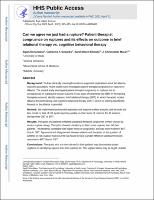Please use this identifier to cite or link to this item:
https://hdl.handle.net/20.500.12202/9816| Title: | Can we agree we just had a rupture? Patient-therapist congruence on ruptures and its effects on outcome in brief relational therapy versus cognitive-behavioral therapy. |
| Authors: | Zilcha-Mano, Sigal Eubanks, Catherine F. Bloch-Elkouby, Sarah Muran, J. Christopher 0000-0002-0561-1607 |
| Keywords: | alliance congruence alliance ruptures vigilant stance psychotherapy process |
| Issue Date: | 2020 |
| Publisher: | US : American Psychological Association US : Wm. C. Brown Co. |
| Citation: | Zilcha-Mano, S., Eubanks, C. F., Bloch-Elkouby, S., & Muran, J. C. (2020). Can we agree we just had a rupture? Patient-therapist congruence on ruptures and its effects on outcome in brief relational therapy versus cognitive-behavioral therapy. Journal of Counseling Psychology, 67(3), 315–325. |
| Series/Report no.: | Journal of Counseling Psychology;67(3) |
| Abstract: | Abstract (English): •To draw clinically meaningful evidence-supported implications about the alliance-outcome association, recent studies have investigated patient-therapist congruence on ruptures in alliance. The present study investigated patient-therapist congruence on ruptures and its consequences on subsequent session outcome in 2 types of treatments that differ in the training therapists receive to identify ruptures: brief relational therapy (BRT), in which therapists receive alliance-focused training, and cognitive-behavioral therapy (CBT), in which no training specifically focused on the alliance is provided. We implemented polynomial regression and response surface analysis, and the truth and bias model on data of 162 dyads reporting weekly on their levels of ruptures, for 30 sessions, during either CBT or BRT. Therapists and patients exhibited substantial temporal congruence in their session-by-session rupture ratings. Therapists showed a tendency to detect more ruptures than did their patients. This tendency correlated with higher levels of congruence and was more evident in BRT than in CBT. Agreement and disagreement between patients and therapists on the question of whether a rupture had occurred was found to have a greater effect on subsequent session outcomes in BRT than in CBT. These findings may suggest that therapists who are more attuned to their patients may demonstrate greater vigilance in identifying ruptures than their patients do. This vigilant stance may be taught. Greater congruence may result in better subsequent session outcome throughout treatment in BRT than in CBT. (PsycInfo Database Record (c) 2020 APA, all rights reserved) Impact Statement: • Public Significance Statement—The findings of the present study join those of previous research showing that therapists tend to show a more vigilant stance and report more alliance ruptures than their patients do. The current study is the first to suggest that therapists can be trained to adopt a more vigilant stance, to carefully monitor the alliance, and to show greater sensitivity to minor nuances in the alliance. The findings further suggest that in brief relational therapy, in which alliance rupture resolution is conceptualized as a main mechanism of change, patients’ and therapists’ agreement and disagreement on whether a rupture in the alliance has occurred has a greater impact on subsequent session outcome than in treatment in which this is not the case (cognitive-behavioral therapy). This finding supports the underlying therapeutic processes conceptualized to bring about therapeutic change in brief relational therapy, in which negotiating such agreement and disagreement is perceived as a main mechanism of change. (PsycInfo Database Record (c) 2020 APA, all rights reserved) |
| Description: | Scholarly article / Open access |
| URI: | https://www.ncbi.nlm.nih.gov/pmc/articles/PMC7125015/ https://hdl.handle.net/20.500.12202/9816 |
| ISSN: | 0022-0167 (Print) 1939-2168 (Electronic) |
| Appears in Collections: | Ferkauf Graduate School of Psychology: Faculty Publications |
Files in This Item:
| File | Description | Size | Format | |
|---|---|---|---|---|
| Ferkauf 2020 Can we agree nihms-1053071.pdf | 420.84 kB | Adobe PDF |  View/Open |
This item is licensed under a Creative Commons License

